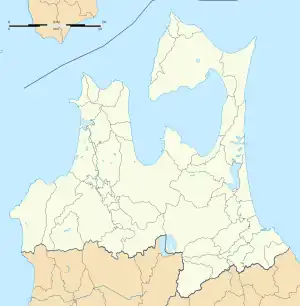Kominato Station
Kominato Station (小湊駅, Kominato-eki) is a railway station of the Aoimori Railway Line located in the central district of the town of Hiranai in Aomori Prefecture, Japan. The station has been operating since 1891, though the most recent station building, which consists of a side platform and an island platform connected to the station building by a footbridge, was completed in 1986. Since 2010, the station has been operated by the Aoimori Railway Company, a third sector, regional rail operator. It is the busiest railway station in Hiranai.
Kominato Station 小湊駅 | |||||||||||
|---|---|---|---|---|---|---|---|---|---|---|---|
| Regional rail station | |||||||||||
 Kominato Station viewed from the southeast in February 2018 | |||||||||||
| General information | |||||||||||
| Location | 12-1 Shitada, Kominato, Hiranai, Higashitsugaru District, Aomori Prefecture 039-3321 Japan | ||||||||||
| Coordinates | 40°55′47″N 140°57′18″E | ||||||||||
| Operated by | |||||||||||
| Line(s) | ■ Aoimori Railway Line | ||||||||||
| Distance | 94.5 km from Metoki 27.4 km from Aomori | ||||||||||
| Platforms | 1 island + 1 side platform | ||||||||||
| Tracks | 3 | ||||||||||
| Connections | Shimokita Kōtsu Bus | ||||||||||
| Construction | |||||||||||
| Parking | Free parking nearby | ||||||||||
| Bicycle facilities | Bicycle racks | ||||||||||
| Other information | |||||||||||
| Status | Staffed (Midori no Madoguchi) from 6:30 am to 3:10 pm | ||||||||||
| Website | Official website | ||||||||||
| History | |||||||||||
| Opened | 1 September 1891 | ||||||||||
| Rebuilt | 1 September 1986 | ||||||||||
| Passengers | |||||||||||
| 844 daily boardings (2018) | |||||||||||
| Services | |||||||||||
| |||||||||||
| Location | |||||||||||
 Kominato Station Location within Aomori Prefecture  Kominato Station Kominato Station (Japan) | |||||||||||
Passenger trains serve the station 17 hours a day; the departure time between trains is roughly 30 minutes during the morning peak with reduced frequency at other times. The station also serves as a bus station for Shimokita Kōtsu, with local bus routes connecting the station and central Hiranai to communities throughout the town.
Location
Kominato Station is located at the northern terminus of Aomori Prefecture Route 215, a 779-meter-long (2,556 ft) road that provides access to the station from Japan National Route 4 in central Hiranai.[1] The station is situated at the northern edge of the urban core of Hiranai and is in close proximity to the town hall, the library, Kominato Elementary and Middle Schools, several historic landmarks, and the local history museum of Hiranai; all of which lie just south to the station.[2][3]
At the time of the station's inception, it was located one hundred meters away from the hall of Nakahiranai; however, as of 2021 the site is occupied by the local history museum.[4] To the north of the station is a snow barrier forest that protects the railway from heavy snowfall.[5] Kominato Station is served by the Aoimori Railway Line, and is 27.4 kilometers from the northern terminus of the line, Aomori Station, and 94.5 kilometers from the southern terminus of the line at Metoki Station. It is 711.8 kilometers from Tokyo along the original Tōhoku Main Line. The stations adjacent to Kominato Station along the Aoimori Railway Line are Shimizugawa Station and Nishi-Hiranai Station.[6]
Station layout
Kominato Station has an island platform and a side platform serving three tracks.[7] The island platform is connected to the station building and side platform by a footbridge. Only tracks 1 and 3 are used by trains moving through the station, the rails for track 2 are used only as a siding, giving the station an effective structure of two opposed side platforms.[8][9] The station building is attended from 6:30 am to 3:10 pm each day, and has a Midori no Madoguchi staffed ticket office. Tickets can be purchased at an automatic dispenser while passenger trains are running.[10] While station staff are present, official stamps for Kominato Station and the other train stations of Hiranai can be obtained.[11] The area outside of the station entrance features public bicycle racks and a parking lot.[12]
Platforms
| 1 | ■ Aoimori Railway Line | for Asamushi-Onsen and Aomori |
| 2 | ■ Aoimori Railway Line | (siding) |
| 3 | ■ Aoimori Railway Line | for Hachinohe |
Public art
A major component of the station's architecture is the elevated footbridge linking the island platform to the station building. The raised structure contains the station's sole piece of public art; a series of paintings depicting scenes from around Hiranai showcasing the town's landscapes, flora, fauna, and industry created by the art club of the Hiranai branch of Aomori-Higashi High School in 2001. By 2012, the installation had begun to deteriorate, so students from the same school spent two months cleaning the art installation and the station building before repairing and repainting the scenes between October 2012 and December 2012.[13]
History
Construction of the Ueno–Aomori line of the Nippon Railway and Kominato Station began in the former village of Nakahiranai in 1890. Supplies were unloaded at a nearby port, Asadokoro, and transported to the build site that was centered on Kominato Station.[14] The station was opened to traffic on 1 September 1891. The Nippon Railway originally intended for Kominato Station to be the northern terminus of the rail line, but Aomori Station was eventually selected.[15] During the winter following the station's opening, snow would blow in from the open fields adjacent to the station and the tracks would frequently be blocked by snow. In an attempt to mitigate the snow blockages, trees were planted adjacent to the station in May 1892 to create a barrier between the fields and the railway.[5] It became a station on the Tōhoku Main Line of the Japanese Government Railways (JGR), the pre-war predecessor to the Japan National Railways (JNR), after the nationalization of the Nippon Railway on 1 November 1906.[16]

The station escaped destruction during World War II and was developed during the war as a backup terminal station to prepare for the eventuality of Aomori Station being destroyed. Aomori Station was destroyed during the strategic bombing of Aomori on 28 July 1945, and Kominato Station picked up the destroyed station's role as the terminal station of the Tōhoku Main Line until the reconstruction of the former was completed on 15 July 1949.[15] In 1961, the reconstruction of Kominato Station began, with the aim of replacing the World War II-era building. As an early phase of the project, the elevated footbridge at the station was installed on 29 June 1961.[17] Regularly scheduled freight services were discontinued in February 1962 and the reconstruction of the station building was completed the same year.[18][19]

It was being considered for closure in March 1972 due to financial difficulties for the JNR, but the people of Hiranai successfully protested the motion to close the station.[18] The current station building was opened on 1 September 1986—the station's 95th anniversary—replacing the one built in 1962.[14] With the privatization of the JNR on 1 April 1987, the station came under the operational control of East Japan Railway Company (JR East).[20] Beginning on 1 April 2004, the station building was operated by Jaster Co., Ltd., a subsidiary of JR East, with a ticketing window for ordinary tickets, express tickets, and reserved-seat tickets for all JR lines.[21]
On 4 December 2010, the Tōhoku Shinkansen was successfully extended north to Shin-Aomori Station from Hachinohe.[22] As a result of the opening of the bullet train between the two stations, that section of the Tōhoku Main Line including this station was transferred to the Aoimori Railway Company from JR East on the same day.[23] The exchange of management was celebrated by the government of Hiranai by the town hall offering free scallop and fish ball soup—a specialty of the town—to every person who visited Kominato Station on the day of the change.[24] Under the management of the regional railway, the station is run as a part of a public–private partnership between the government of Aomori Prefecture and the Aoimori Railway Company.[23] The station was renovated most recently in the summer of 2018.[9] On 13 March 2021, the Shimokita service operated jointly by JR East and the Aoimori Railway between Aomori and Ōminato that stopped at Kominato Station was abolished.[25][26]
Services
.jpg.webp)
The station is primarily served by trains operating on a local service on the Aoimori Railway Line between Aomori and Hachinohe. It is served by one rapid express train, the 560M train operated jointly by the Aoimori Railway and the Iwate Galaxy Railway between Aomori and Morioka. Passenger trains serve Kominato Station just over 17 hours a day from 6:10 am to 11:21 pm. At peak hours between the first train and 9:06 am, trains depart from the station roughly every 30 minutes; otherwise trains depart at an approximate hourly basis.[26] In 2018, a daily average of 844 passengers boarded trains at Kominato Station,[27] an increase from the daily average of 410 passengers the station served in 2010, the final year of its ownership by JR East.[28] In 2018, the station was the eighth busiest on the Aoimori Railway Line, excluding Aomori and Hachinohe stations. It has been the busiest station along the Aoimori Railway Line in Hiranai throughout the line's existence.[27]
Bus services
Kominato Station also functions as a bus station, with five municipal bus lines stopping at the station and one seasonal long-distance bus stopping nearby. Shimokita Kōtsu, the operator of Hiranai's municipal bus network, operates the local routes that stop at the station, traveling to points within the town including Higashitaki, Asadokoro, Higashitazawa, Moura, Nakano, Inaoi, Soto-Dōshi, Matsunoki, Shimizugawa, Karibasawa, and Nakano, as well as providing a connection to the Aomori City Bus at Asamushi Onsen.[29] Tickets can be purchased for seasonal Kōnan Bus Company services to Shinjuku at Kominato Station; however, the bus picks passengers up from the Hiranai Community Center within walking distance rather than at Kominato Station.[30]
See also
References
- "道路情報(東青地域県民局地域整備部)" [Road information (Aomori Metropolitan Prefectural Bureau Regional Development Department)] (in Japanese). Aomori Prefecture. 3 December 2015. Retrieved 11 March 2021.
- "平内都市計画区域の整備、開発及び保全の方針" [Hiranai municipal planning area maintenance, development, and conservation policy] (PDF) (in Japanese). Aomori Prefecture. May 2004. Retrieved 12 March 2021.
- "平内町観光ロードマップ" [Hiranai Sightseeing Map] (PDF) (in Japanese). Hiranai. 10 March 2017. Retrieved 12 March 2021.
- "平内町" [Hiranai] (in Japanese). Aoimori Railway Co.,Ltd. 2020. Retrieved 12 March 2021.
- "鉄道文化財をめぐる(7) 日本初の鉄道防雪林120周年" [Railway Cultural Properties (7) 120th Anniversary of Japan's First Railway Snow Forest] (in Japanese). Nippon Travel Agency. 18 October 2013. Retrieved 11 March 2021.
- "路線図" [Route map] (in Japanese). Aoimori Railway Co.,Ltd. 2021. Retrieved 12 March 2021.
- Mimura, Shingo (31 March 2020). "移動等円滑化取組報告書(鉄道駅)" [Report on smooth movement, etc. (railway stations)] (PDF) (in Japanese). Aomori Prefecture. Archived from the original (PDF) on 27 March 2021. Retrieved 27 March 2021.
- "青い森鉄道、小湊駅でホーム補修工事を実施 7月17日から" [Platform repair work carried out at Aoimori Railway Kominato Station from July 17]. RailLab.jp (in Japanese). 15 July 2018. Retrieved 16 March 2021.
- "小湊駅1番線 工事に伴う停車位置変更のお知らせ" [Notice of change in stopping position due to construction on Line 1 at Kominato Station] (in Japanese). Aoimori Railway Co.,Ltd. 21 November 2017. Archived from the original on 1 February 2018. Retrieved 31 January 2018.
- "小湊駅" [Kominato Station] (in Japanese). Aoimori Railway Co.,Ltd. 2021. Retrieved 12 March 2021.
- "駅スタンプ設置一覧表" [List of station stamp locations] (PDF) (in Japanese). Aoimori Railway Co.,Ltd. 16 March 2019. Retrieved 19 March 2021.
- "公共建築物" [Public buildings] (PDF) (in Japanese). Town of Hiranai. 1 February 2017. Retrieved 12 March 2021.
- "先輩達の壁画をリフレッシュ" [Refresh the murals of our seniors] (PDF). Hiranai Town Magazine (in Japanese). Town of Hiranai. January 2013. Retrieved 12 March 2021.
- Hiranai History Compilation Committee (1 July 2005). 平内町史 年表 [Hiranai History Timeline]. Hiranai. p. 54.
- "駅や築港は国策に翻弄" [Stations and ports are at the mercy of national policy]. Mutsu Shimpō (in Japanese). 9 March 2015. Retrieved 12 March 2021.
- "鐵道國有法" [Railway Nationalization Act]. Act of 1906 (in Japanese). Imperial Diet. Retrieved 21 March 2021 – via Wikisource.
- 小湊駅こ線橋 [Kominato Station elevated footbridge] (Plaque on the bridge) (in Japanese). Hiranai: Senken Construction. 29 June 1961.
- Hiranai History Compilation Committee (1 July 2005). 平内町史 [Hiranai Town History] (in Japanese). Vol. 3. Hiranai. NCID BN 04492514.
- Hiranai History Compilation Committee (1 July 2005). 平内町史 年表 [Hiranai History Timeline]. Hiranai. p. 98.
- "日本国有鉄道の改革の実施に当たり河川管理上留意すべき事項について" [Matters to be noted in management when implementing the reform of the Japanese National Railways] (in Japanese). Ministry of Land, Infrastructure, Transport and Tourism. 30 March 1987. Retrieved 12 March 2021.
- "基本的なコンセプトは「結ぶ」" [The basic concept is "to tie"] (in Japanese). Jaster Company. 2005. Archived from the original on 24 October 2005. Retrieved 12 March 2021.
- "Tokyo-Aomori bullet train debuts". The Japan Times. Aomori. Kyodo. 5 December 2010. Retrieved 21 March 2021.
- "青い森鉄道線について" [About the Aoimori Railway Line] (in Japanese). Aoimori Railway Co.,Ltd. 2021. Retrieved 11 March 2021.
- "祝・青い森鉄道が開業!ホタテのつみれ汁でおもてなし" [Celebration – Aoimori Railway opens! Treating visitors with scallop and fish ball soup] (PDF) (in Japanese). Town of Hiranai. Retrieved 15 March 2021.
- "12月4日ダイヤ改正後の青森地区列車運転体系" [Operating pattern of Aomori area trains following the 4 December timetable revision]. Tetsudō Daiya Jōhō Magazine (in Japanese). Vol. 39, no. 320. Japan: Kōtsū Shimbun. December 2010. pp. 24–25.
- "青い森鉄道列車時刻表" [Aoimori Railway Train Timetable] (PDF) (in Japanese). Aoimori Railway Co.,Ltd. 25 February 2021. Retrieved 15 March 2021.
- "小湊駅(青い森鉄道)の乗降客数の統計" [Passenger statistics of Kominato Station]. statresearch (in Japanese). 2021. Retrieved 12 March 2021.
- "各駅の乗車人員" [Passengers at each station] (in Japanese). JR East. 2010. Retrieved 12 March 2021.
- "内町民バス時刻表" [Town people's bus timetable] (in Japanese). Town of Hiranai. 14 March 2020. Retrieved 11 March 2021.
- "青森-八戸-新宿を結ぶ高速バス" [Highway bus connecting Aomori-Hachinohe-Shinjuku] (in Japanese). Kōnan Bus Company. 2021. Retrieved 21 March 2021.
External links
- Official website (in Japanese)